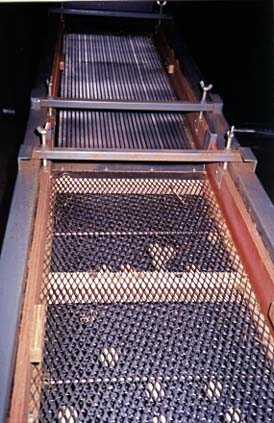 |
||||||||||||
| When the wild rice in its hulls exits the fourth parcher, a moving belt (conveyer belt) takes it to a series of screeners with different types of screens. When harvesters bag their crop, they can't help it if some leaves and stems from the wild rice plant and a few stones come along for the ride.
The screening process gets rid of most of that. In the picture you can see small slits at the far end and larger netting closer to you. The screens vibrate and are tilted so the mixture of wild rice and other stuff will move along towards you. |
||||||||||||
| First the mixture will pass over the small slits (called a sift screen). Small stones drop through but the wild rice stays on top. Next the mixture will pass over the large netting (called a scalp screen). Small things the size of wild rice and hulls fall through the scalp screen and are transferred to a conveyer belt. [pictured on the next page] Meanwhile, any larger unwanted material is held by the screens and discarded.
When we design the scalp screens (large netting), we don't want the wild rice to be trapped too. That's wasteful. So we need to make the screen holes large enough for all the wild rice to drop through (pulled by gravity, of course). This means that other small material can fall through as well (e.g. flakes of leaf of stem, dirt particles, and once in a while a small foreign object such as a tiny stone that didn't drop out earlier through the sift screen). This unwanted material will be cleaned out later in other machines. |
||||||||||||
|
|
||||||||||||
|
Click on a page number to move within the site. |
||||||||||||